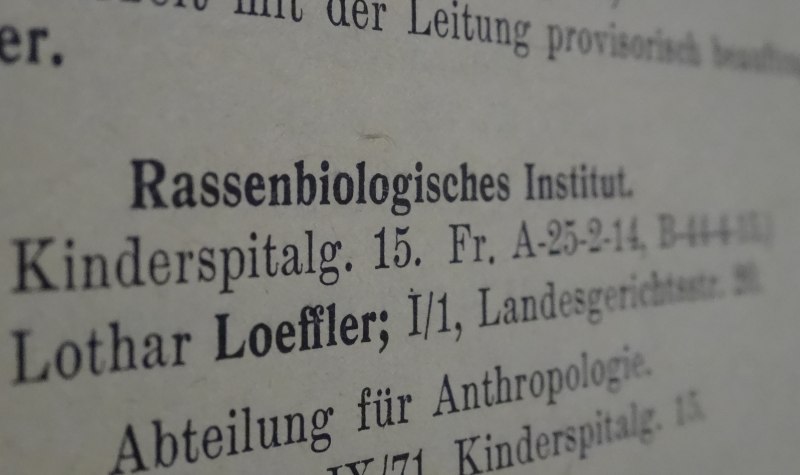Internal restructuring towards National Socialist science
The National Socialists not only implemented their ideology in many ways in university politics, the introduction of the “Führer principle” also had a significant impact on the internal university structure: Teaching and research were reoriented towards “völkisch” (“ethnic”) aspects and exploited for the “Endsieg” (“ultimate victory”). Here, the interests of politics outside of the university and those of the participating academics met.
Numerous teachers adapted their lectures to the new political circumstances and ideological provisions as early as the winter semester of 1938/39, giving the faculties’ academic focuses a racist and imperialist character. With the beginning of the Second World War, teaching and research received an orientation towards the demands of the war, making large sums of money available for certain fields of research, despite the difficult economic situation due to the war.
New appointments and the creation of new professorial chairs and institutes were effective measures for the reorientation and establishment of new, politically motivated research and teaching focuses. Noteworthy are the foundation of the University Institute for Physical Exercise (1938), the Institute for the Unification of Law (1940), the Institute of Household Studies (1940, since 1942 Institute of Women’s Work), the Institute of Special Dogmatics (1941), the Institute of Journalism (1942), the Institute of Theater Studies (1943), the Institute of Germanic-German Ethnology (1943), the Institute for Interpreter Training (1943), and the Institute of Postal History (1943).
Apart from the University Institute for Physical Exercise founded in 1938, which became important through the mandatory exercises for all students under the banner of “selection” and “militarization”, the Institute of Household Studies (“Lebenswirtschaftskunde”) founded in 1940 and renamed to the Institute for Women’s Work (“Fächer des Frauenschaffens”) in 1942 also had significant practical relevance. In accordance with the National Socialist ideal of the German woman and mother, the latter offered a course of studies for housekeeping and family. The Institute for Interpreter Training (1943) furthermore also had a foundation in reality, in regard to the German Reich’s planned future role as a global power.
The institutes for the young academic subjects of journalism and theater studies founded in 1942 and 1943, respectively, were “prestige projects” of high-ranking political officials, while the Philosophical Faculty, at which they were established, was not happy with the exertion of influence from outside the university. Mainly financed by the Reich Ministry of Public Enlightenment and Propaganda, the Institute of Journalism laid its teaching focus on the training of young National Socialist journalists and its research focus on questions of the enemy press and friendly press politics and propaganda. The Institute of Theater Studies, meanwhile, that had its prominent seat in the Hofburg, helped Vienna present itself as the cultural center of the Reich and thus also received a remarkably high budget. Two young academics in line with the National Socialist ideology were appointed as the heads of these two institutes, with the process being delayed by various internal power struggles. Together with the Institute of Postal History (1943), these institutes reveal a strong interest of the National Socialist rulers in questions of propaganda and information brokerage. In the establishment of the Institute of Germanic-German Ethnology in 1943 the National Socialist ideology can also clearly be seen as a driving force.
Meanwhile, other fields of research were also significantly enhanced due to the political interests, such as the Southeastern Studies at the Philosophical Faculty. Eastern Studies had already established themselves in the German-speaking world as an interdisciplinary and transregionally networked research program before 1933. Leading experts of ethnic studies from various disciplines began developing the concept of German “Lebensraum im Osten” (“Habitat in the east”) here after the National Socialists came into power. In the decentral organization, the Southeast-German Research Association in Vienna was particularly concerned with the successor states of the Austro-Hungarian monarchy.
In 1938 the Philosophical Faculty, which had already long been dominated by conservative, German-nationalistic and anti-democratic ideas, did not really need to be reoriented. A continuity of people, methods and content could especially be observed in the ideologically relevant subjects such as history and German philology. The “applied sciences” in Vienna were supposed to offer the basis for decisions and justifications for the National Socialist expansion into Southeast Europe – the colonialization of Eastern European countries, the exploitation of their resources and the degradation of the Slavic peoples to “servants” of their German masters. In 1940 the five Viennese universities were consolidated into the “Südostgemeinschaft” (“Southeastern Association”), in 1941 other Austrian universities joined the group.
The newly founded Institute for the Unification of Law at the Faculty of Law and Economics was intended to help create a “uniform German legislation soaked with National Socialism”, but also to “ensure the basis for the influencing of legal development in the southeastern area”.
The Racial Biological Institute founded in Vienna in 1942 consolidated the disciplines trying to “scientifically” justify the National Socialist racial and bio-political doctrine currently divided into six different departments (anthropology, racial hygiene, pathology of inheritance, psychology, neurology and psychiatry, experimental genetics, heritage statistics) and served politics as a consultant in questions of “heritage”. From 1939 onwards, in regard to teaching, questions of “military hygiene”, “military surgery”, “military toxicology” etc. played a far larger role than lectures on racial hygiene.
Particularly within non-university institutions there were personal ties to the National Socialist system of persecution, such as at the police or security police, and very obviously at the “Kinderfachabteilung” (“children’s ward”), the “Wiener Städtische Nervenklinik” (“Vienna City Mental Hospital”) “Am Spiegelgrund”, where children were murdered. Their bodies were dissected in 1942 at the Anatomical Institute of the University of Vienna and were used in research. Numerous physicians who were involved with the National Socialist politics of extermination were not brought to justice after the Second World War.
After the end of the war, the Institutes of Postal History, Racial Biology, and Unification of Law were closed.
Zuletzt aktualisiert am : 05.03.2024 - 21:11


